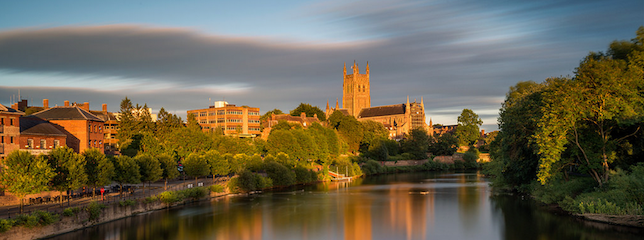Top 5 Historical Hotspots in Worcestershire
Although its name is infamously difficult to pronounce and you’ve only heard of it because of your favourite tangy sauce, there’s a lot more to tickle your taste buds in Worcestershire than a mere bottle of Lea and Perrins! The county is in fact steeped in history. From being the birthplace of Edward Elgar, to its eponymous city being the site of the last battle of the English Civil War (Worcester was the last city loyal to the king earning it the title “The Faithful City”), we’ve rounded up the Top 5 historical sites for you to visit in this fascinating county.

Worcester Cathedral
Dating back to 1084, Worcester Cathedral was originally built by the then Bishop of Worcester St. Wulfston, and the view of its 203-ft tower (which you can climb for a panoramic perspective of the city) against the River Severn is the defining image of the city. It’s undergone a lot of renovation during its long history resulting in a beautiful collage of styles, but these changes haven’t only been architectural. From being home to an Anglo Saxon monastery until dissolution under Henry VIII to being occupied by the Parliamentarians during the Battle of Worcester, the Cathedral has been an epicentre of historical change. It is also home to the tomb of “bad†King John, which is adorned with a life-like effigy dating back to 1232 and making it the oldest in England.
 Image Credit: David Ilif via Flickr
Image Credit: David Ilif via Flickr
Worcester Cathedral is located at 8 College Yard, Worcester, WR1 2LA
Harvington Hall
This moated Medieval and Elizabethan manor house is visually impressive, but it’s the inside of this historical building that’s truly fascinating. Hidden between the walls of Harvington Hall is the largest surviving series of priest hides in the country, which were built by Nicholas Owen to hide Catholic priests during the 16th century Reformation. Whilst the priest hides are the main attraction, Harvington is also home to rare wall paintings from the 1500s, a Georgian chapel, herb and wildflower gardens, and also organises various special living history events, bringing the house to life with musket demonstrations, archery, historic cooking, music recitals and dancing.
 Image Credit: Ozzy Delaney via Flickr
Image Credit: Ozzy Delaney via Flickr
Harvington Hall is located at Harvington Hall Lane, Harvington, Kidderminster, Worcestershire, DY10 4LR
Avoncroft Museum
In the town of Bromsgrove, Avoncroft - set up like a miniature village - is a museum of historic buildings and structures that have been saved from demolition. The collection now boasts over 30 historic buildings including a 1870s Herefordshire cell block, a 1930s counting house from Bromsgrove Cattle Market, a Medieval townhouse, an icehouse and even the National Telephone Kiosk collection, with phone boxes dating back to 1912. Avoncroft is also home to a miniature railway owned by the Bromsgrove Society of Model Engineers, which visitors wishing to derail from their tour of historic structures can get aboard for an experience ride.
 Image Credit: Mike Wilson via Flickr
Image Credit: Mike Wilson via Flickr
Avoncroft Museum is located at Stoke Heath, Bromsgrove, B60 4JR
Witley Court once attracted 1890s high society - including the Prince of Wales/ future King Edward VII - for fashionable and decadent parties. However, after a tragic house fire in 1937, the country house is now tragically, but extremely photogenically, left in ruin. Definitely a summer venture due to the lack of roof, after you’ve perused the charred timbers, you can find a perfect picnic spot in Witley Court’s beautifully landscaped garden, with its recently refurbished Perseus and Andromeda fountain (Bing Crossby was reportedly determined to re-erect the fountain on a gold course in Chicago) as the dazzling centre piece to gaze upon as you munch your sandwiches. Before you leave, don’t miss the stunning Great Witley Church, which was untouched by the fire.
 Image Credit: kennysarmy via Flickr
Image Credit: kennysarmy via Flickr
Witley Court is located at Worcester Road, Great Witley, WR6 6JT
Droitwich Spa Brine Baths and Lido
The historic town of Droitwich Spa is famous for being situated on massive salt deposits, which were extracted by the Romans through to the Middle Ages. In the 19th Century, local Black-Country lad John ‘The Salt King’ Corbett revolutionised salt production in Droitwich. He later developed the town as a Spa, building the St. Andrew’s Brine Baths in 1888 which became famous for treating rheumatic and arthritic problems. Unfortunately, the Brine Baths were closed in 2008 and are no longer open to the public, but there is a local campaign to save this staple of the town’s history. Meanwhile, you can visit the Droitwich Spa Lido when it opens for the summer season, which is one of the few remaining open-air, inland, salt-water swimming pools in the UK. Whilst it’s not in its original art-deco 1930s state, it’s definitely a perfect way to cool off from all your heated historical research.
 Image Credit: lidos_org_uk via Flickr
Image Credit: lidos_org_uk via Flickr
Droitwich Spa Lido is located at the Lido Park, Worcester Road, Droitwich Spa, Worcs, WR9 8AA